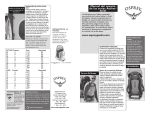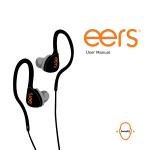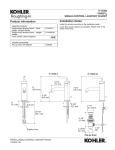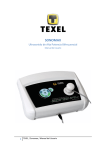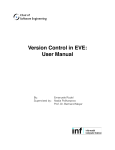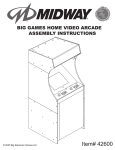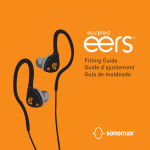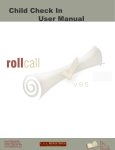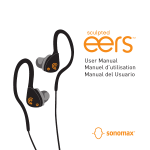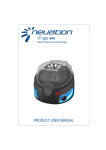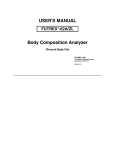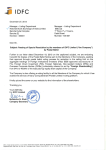Download sculpted eers review published in March 30, 2012 ComputorEdge
Transcript
sculpted eers review published in March 30, 2012 ComputorEdge Custom fit your eers Earphonesʼ audio quality depends upon various factors, one of which is tightness of fit. The tighter that earphonesʼ silicone or foam tips insert into the userʼs ear canals, the better the audio quality (especially bass). Because ear canals can vary in shape and size, usersʼ challenge is to purchase earphones with tightly fitting tips. Custom molded tips would provide the best fit, but they involve the time and expense of visiting an audiologist. Sonomax Technologies Inc. has devised a more convenient and affordable alternative—SonoFit—that is included with their sculpted eers line of earphones. The PCS-100 is the subject of this review. The PCS-100 earphones (Figure 1) cost $169.99 direct from the company. This price tag includes the SonoFit custom molding system (details in a moment), a 3 ml tube of water-based lubricant, black faceplates with the eers logo and the letter L or R highlighted in red, a black carrying pouch big enough for the earphones and lubricant tube, and 4" x 4" printed user manual plus fitting guide (both in English, French, and Spanish). These earphones are entry-level; Sonomax Technologies also sells PCS-150, −200, and −250 models with higher price tags. Figure 1. The PCS-100 earphones have a 50" cable with highly flexible ear loops at one end and a standard 3.5mm gold-plated stereo jack at the other. A plastic splitter (blue oval) without a microphone or remote controls (volume; pause/play) is located ~11.5" below the bottom of the ear loops. A plastic slider (red rectangle) above the splitter helps minimize audio artifacts due to movement. Specifications for this product are as follows. • single driver, dynamic speaker • 3.5 mm (1/8'') gold-plated stereo jack 1 • weight: ~15 g (0.53 oz) • 1.3 m (50") kink-resistant cables • nominal impedance: 32 ohms • sensitivity: 103 dB SPL /100 mVrms @1 kHz • maximum output level: 115 dB SPL • frequency response curve: 18Hz - 16kHz Sonomax Technologiesʼ packaging for the PCS-100 is bulky, presumably to ensure sufficient protection. It measures 10.75" x 11.5" x 2.125", tips the scale at 1.3 pounds, and consists of a cardboard outer sleeve and an inner box (Figure 2A). Inside the inner box is a plastic bag containing a tray. The tray includes a clear plastic top with a red stop-sign shaped sticker (details momentarily), a black felt-covered plastic middle piece, and a cardboard bottom to which the middle piece is attached (Figure 2B). Figure 2. sculpted eersʼ elaborate packaging consists of an orange cardboard box big enough for two pizzas within a white cardboard sleeve (A). Inside the orange box is a plastic bag containing a tray that has a clear plastic top with a stop-sign shaped sticker, and a black-felt covered plastic middle that houses the earphones and other included items (B). Opening this packaging easily could be a more pleasant experience. After dealing with four pieces of oval tape that seal the orange boxʼs top and bottom, then extracting the box from its white sleeve, and finally cutting open the plastic 2 bag that contains the tray, the user is greeted by a pungent and persistent odor; the primary offender is the trayʼs middle piece, as far as my nose can tell. The red sticker is majorly attention grabbing and new users should carefully read and heed the fine print (Figure 3); it has important instructions about chilling the tray for at least 30 minutes before commencing with the fitting process. Figure 3. The warning sticker says that you must store the PCS-100ʼs unopened tray in an environment below 73 degrees for at least 3 hours or refrigerate it for 30 minutes prior to fitting in order to keep the productʼs warranty valid. The aforementioned tray holds the PCS-100 and accessories, including the SonoFit system which is built into a plastic apparatus resembling conventional headphones (Figure 4). It evidently is designed for a single usage before disposal. Using the SonoFit system involves three steps—positioning, activating, and removal—which are explained very clearly in two downloadable videos (here and here) and in the fitting guide. The videos and guide indicate that this custommolding process is a two-person job which takes less than 10 minutes. They additionally emphasize that the user should keep her/his jaw still without talking while SonoFit does its thing, to ensure a proper mold and fit. The user can forget any worries that the apparatus and/or process will produce discomfort or physical 3 pain, as discussed in the user manual and Sonomax Technologiesʼ FAQ web page. Figure 4. The Sonofit system consists of a plastic apparatus somewhat resembling conventional headphones. It is used once and then…what to do with it? Although SonoFitʼs three steps potentially could be handled by one person, they were facilitated by having a second person during testing for this review; a solo operation probably would have risked a glitch. My testing experience additionally confirmed Sonomax Technologiesʼ disclaimer that SonoFit is painless and harmless. The companyʼs description of the apparatusʼ pinging noise and the userʼs sense of expansion within her/his ear canals while SonoFit is in progress also was confirmed during my testing. After completing the SonoFit process, youʼll soon know whether it successfully produced a proper fit—the PCS-100ʼs ear tips will go directly and fit snugly in your ear canals, and the resulting audio quality should be rich and full rather than bright and shallow thanks to isolation from external noise. My testing experience with SonoFit was successful…sort of. On the one hand, it produced custom molds that were snug enough to block ambient noise such as a loud TV. On the other hand, however, the custom molds were so uncomfortable that I eagerly removed the PCS-100 after listening to only one track during each test session. The discomfort occurred with or without applying the included lubricant on the molds. My tolerance of the discomfort remained low despite awareness of the user manualʼs caveat that the custom molds have a break-in 4 period (like a pair of shoes). Your level of tolerance and/or perceived discomfort could be different from mine. One more point about these custom-fitted molds—unlike silicone or foam tips that come with other earphones, the PCS-100ʼs are relatively inflexible and you need to properly insert them into your ear canals at exactly the same orientation as when the SonoFit produced them. Otherwise, the seal will be only partial and audio quality (especially bass) will suffer. How does the PCS-100 sound, assuming a proper fit? Although my custom-fitted molds yielded at least satisfactory sound isolation, my tunes sounded only OK— perhaps even a tad muddy—with the PCS-100. Individual instruments (lead and bass guitars, keyboards, percussion) and voices in favorite tracks were discernable, but neither sharp nor distinctive. If your current earphones are the standard ones included with an iDevice, youʼd likely be satisfied (although probably not overly impressed) with the PCS-100ʼs sound. Keep in mind that these earphones are an entry-level, single-driver model and some portion of their $169.99 cost covers the single-usage SonoFit system. The following caveats could be worth considering before taking the plunge on these earphones. Perhaps most important, what happens if a glitch occurs during SonoFitʼs process and your custom molds donʼt fit properly afterwards? Evidently youʼre stuck without an Edit>Undo option. The only relevant information I could find in Sonomax Technologiesʼ documentation and web site was the following from the warranty—“Do not return to store. Please contact us…for all product exchanges and questions.” Be forewarned that the company is located north of the border in Montreal. Another consideration is that, if you want to share sculpted eers earphones with someone or decide to sell/donate them, forget it because they fit only your ear canals. This limitation contrasts with competing earphones that accommodate both custom molds and standard sizes of silicone or foam tips. One final point about the custom molds…the user manual recommends moistening them with the included lubricant (or even with saliva; eew!) prior to insertion into your ear canals. This recommendation is intended to facilitate proper insertion (possibly because the custom molds are relatively rigid; silicone and foam tips included with other earphones typically are pliable, making 5 lubrication unnecessary). The downside of this is that it reduces the time available for listening. The PCS-100ʼs durability is an important characteristic which could not be evaluated within the scope of this review. These earphonesʼ right-angle stereo jack (Figure 1) is well designed and its materials feel rugged enough to expect minimal risk of breakage at the jackʼs junction with the cable. The cables and ear loops are a question mark, however; their material has a more rubbery texture than previously reviewed earphonesʼ counterparts. Whether this rubberiness is indicative of a long or short lifespan, low or high risk of breakage, remains to be determined. Speaking of the ear loops and cables, the former are a permanent part of the PCS-100. If you are not a fan of ear loops in general, these earphones likely are not for you. The cablesʼ splitter (Figure 1) would be more functional and useful if it had incorporated a microphone for cellphone calls and remote controls for volume and play/pause. Lastly, sculpted eers are not very environmentally friendly. The trayʼs plastic parts do not have a recycle badge; they presumably are destined for the landfill instead of a reusable future. How can the user responsibly dispose of the SonoFit apparatus? Does it contain hazardous chemicals? I could not find any relevant information on the companyʼs web site or in the printed materials. In summary, the convenience and relatively low cost of a do-it-yourself custom molding system is very appealing, thus the entry-level PCS-100 could attract casual users who want to replace an iDeviceʼs standard earphones. Serious listeners could be disappointed by the PCS-100ʼs audio quality, however; the higher-end sculpted eers models potentially could be better options. reviewed by Barry Fass-Holmes 6







